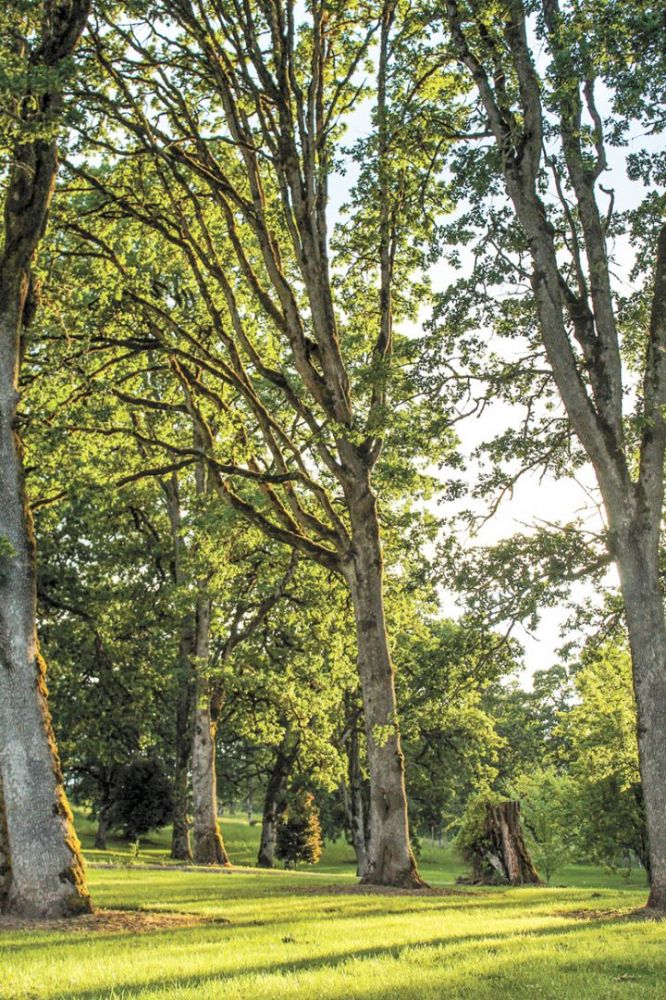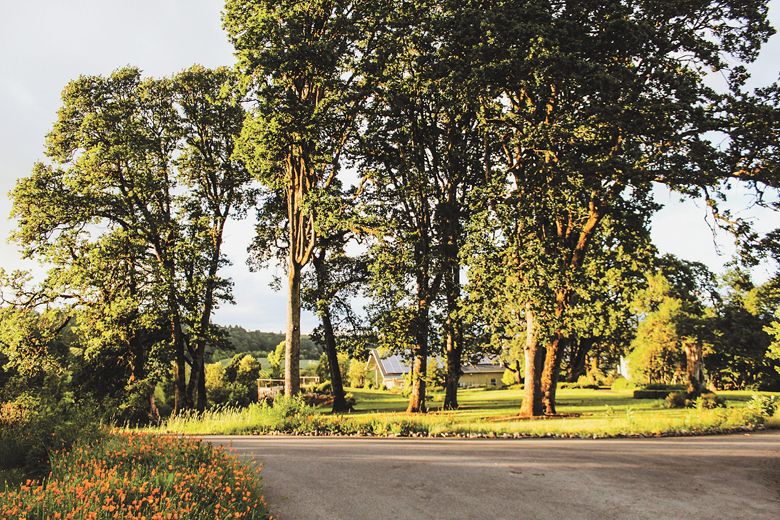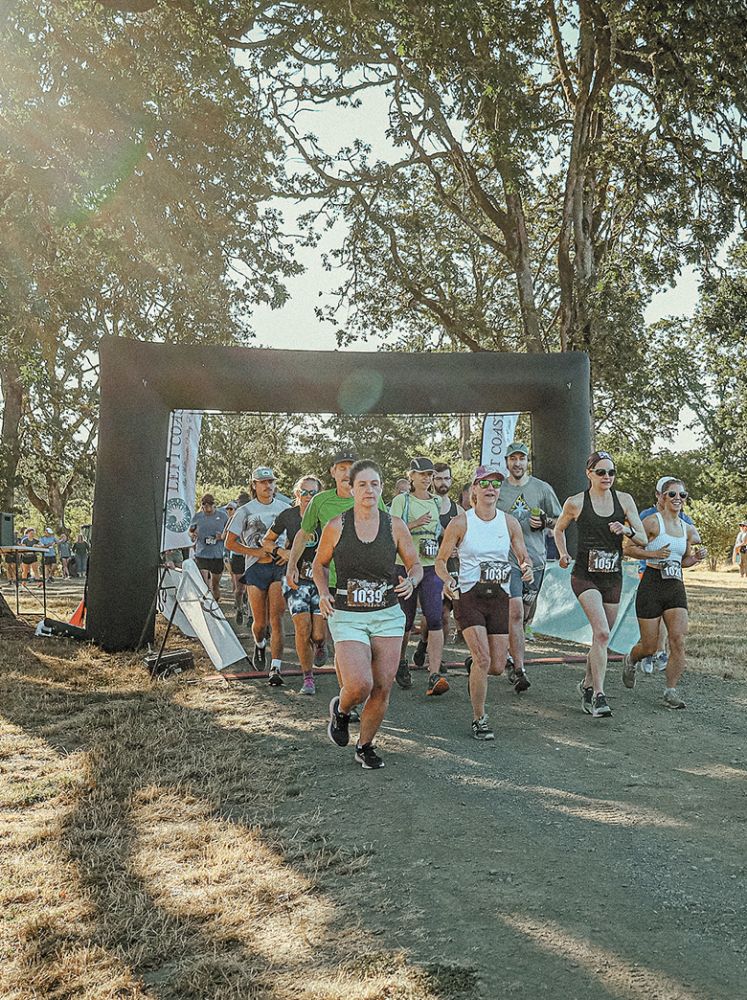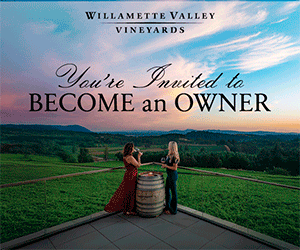A Mighty Tall Task
Saving Oregon white oaks before they disappear



By Patty Mamula
In the 19th century, Oregon white oaks dominated the Willamette Valley. Today, less than 10 percent of these oak trees remain. According to Nicole Maness at Willamette Partnership – a Portland-based conservation nonprofit, continued development is a major factor in the declining numbers. The Willamette Valley Oak Accord, a voluntary pledge by private landowners to protect white oaks, was formally signed in 2017. The significant loss of oak habitat, woodlands and savannas was the impetus.
Mimi Casteel, a trained forest ecologist and owner of Hope Well Wine, remembers an annual meeting hosted by Low Input Viticulture and Enology, commonly known as LIVE, in which Maness spoke about a program to protect the Fender’s blue butterfly. Casteel, along with her mother Pat Dudley from Bethel Heights Vineyard, felt more concerned about habitat loss at the behest of agriculture, particularly viticulture.
The presentation sparked a conversation about the importance of distinct habitats. Members of the wine community realized they needed to unify and support habitat diversity and recruited Maness to organize their efforts. She agreed to serve voluntarily.
The Oak Accord makes a pledge to protect and restore white oak throughout the Willamette Valley. There were about 40 original signatories to the Accord. “There wasn’t anyone we spoke to who didn’t want to do oak restoration,” said Maness.
Many of those original signatories have made significant progress on their commitment to oak. “Left Coast Estate began a formal oak restoration and preservation program in 2015 through the Partners Program with U.S Fish and Wildlife,” said Taylor Pfaff, CEO of Left Coast Estate whose family bought the nearly 500-acre estate in 2003. “We situated the tasting room around a mature oak stand. We didn’t want to cut it down because the trees were so beautiful and relaxing,” he said.
A project manager for the Fish and Wildlife service was amazed at the diversity of oaks after hiking a loop on their property. “He opened our eyes,” said Pfaff. “And encouraged us to explore other conservation programs through the Natural Resources Conservation Service, or NRCS, to expand our restoration efforts beyond the 40-acre forest already enrolled in the Partners Program.” Since then, they have received additional grants. Nearly 20 percent of their property (105 acres) involve some sort of oak restoration. The mature trees receiving the most sunlight by the tasting room are 200 to 400 years old, with a few close to 500 years.
In 2016, Left Coast Estate started an annual Run for the Oaks, on the first Saturday in August. This 5K walk (or run) and 10K run created a funding source for maintaining the oaks when the restoration contracts expired. The eighth annual Run for the Oaks is August 5. Visit RunForTheOaks.com for more details.
Pfaff said, “The best way to start protecting oaks is to first check with your county offices to see what programs are available for oak preservation.”
Soter Vineyards has been another oak leader. Joel Sokoloff, Soter’s vineyard and ranch manager, said their philosophy is “to preserve the natural environment, the oak habitat and scenic beauty. Doing so breaks up the monoculture of vineyards, too.”
The 240-acre property includes 35 acres under a restoration program through the NRCS.
The variety of oaks on the property range from one to 250 years old, with the most mature reaching 80 feet in height or more. Some of the oldest are in decline. “We’re having to work hard to preserve them,” said Sokoloff. “We have some large canopied oaks spaced far apart and some oak woodlands, more tightly spaced.”
When winery guests visit, they notice some younger seven to 10-year-old oaks. Recent plantings of one-year-old seedings are repopulating grassy hillside areas.
Last year, the oak woodland contained a mixture of oak and fir. “We removed particular firs in order to provide the oaks a better foothold,” said Sokoloff. “We also did quite a bit of brush trimming.” They next planted native underbrush and grassy species. “It’s expensive work,” Sokoloff said.
“While we are a business, we try to farm with the greatest respect for the natural environment, realizing there’s so much more to the land then growing a crop.”
Fairsing Vineyard serves as another model of oak restoration. When Mike and Mary Ann McNally bought the 200 acres in 2005, the property had been clearcut. “Mary Ann handles the vineyards and I manage the forests,” said Mike.
Today, they have about 65 acres in vines, while forest comprises another 100. Because the land had been razed, there weren’t any older, mature oaks. “We first began by nurturing the existing trees. Maples and oaks tend to return first, but the maple trees come back as bushes, choking out the oaks. The remedy is to trim them up as trees,” said Mike.
In 2021, he ordered 1,000 white oak seedlings for a grassy meadow. That summer Oregon experienced an unusual “heat dome.” Without irrigation, many tender saplings died. Even so, if half survive, they will eventually need to be thinned.
“What we’re trying to do is find the place where the oaks want to grow and plant them there. We’ve found they love our south-facing hills,” said Mike.
Over time, he adopted numerous approaches to planting trees. Each year, he fills his pickup with as many one-gallon potted trees from the nursery. He also collects acorns to plant and grows more in coffee cups for transplantation at a later date.
Because Fairsing is LIVE-certified, they don’t use herbicides. The maintenance of mechanically removing the blackberries and Scotch broom becomes more complicated than the oak planting. Over the years, Mike has kept detailed records of the plantings. “We are a certified American Tree Farm, which requires an evaluation and a forestry plan. Even though we don’t plan to commercially use these trees, the certification is valuable,” said McNally.
Maness, through her Oak Accord efforts, works closely with state conservation organizations, recommending grant opportunities to individual landowners. The Yamhill Soil and Water Conservation District, like many others, manages a number of grants, including those through the NRCS. Amie Loop-Frison oversees the contracts.
The grants support endangered species as well as rare and declining habitats. “It’s pretty scary that less than 10 percent of these oaks are left in the Willamette Valley,” said Loop-Frison. These trees are significant parts of peoples’ property that aren’t necessarily making them money but are important for the health of the region.
The three-year allotments are aimed at restoring contiguous oaks on at least one acre. During the first year of the grant, Loop-Frison helps landowners find people to do the clearing. “When we write the plan, we make it a three-year contract. Most of these sites are a mess. That allows us to go in every year. First, we take competing trees down; then, in subsequent years, we mow and spray the understory,” said Loop-Frison.
“Oak restoration is a forever project,” she said. “Once the grant is completed, the landowners takes care of their property themselves.” Loop-Frison is currently working with several other wineries.
Winter’s Hill Estate has 110 acres with 20 of those being restored to oak savannas. Founding partner Emily Gladhart, said, “We plant lots of replacement oaks and a wood turner creates bowls for oak restoration fundraisers with the wood from fallen mature ones.”
Rebecca Moore, principle at MonksGate Vineyard, said oak forests cover about six and a half acres of their 50-acre property. “The restoration project is about cleaning out two forests,” she said. Moore plans an educational hiking trail so visitors learn it’s not all about wine but rather biodiversity.
Moe Momtazi at Momtazi Vineyard and Maysara Winery purchased the 532-acre estate in 1997; he farms the property biodynamically. “We left a lot of oaks, even within the vineyards,” he said. The grant area encompasses 45 acres. “Last year, we removed downed trees along with some smaller, unhealthy ones. Then we cleared the understory and planted grass,” he said.
“Many landowners are working to protect lands, to encourage biodiversity,” said Momtazi. We’re happy to see our neighbors doing the same thing for preservation.”
In terms of the Oak Accord, Maness concedes that conversion is still a huge issue. “Every acre of oak we cut down is very expensive to get back. It’s much cheaper to protect it. We [want] put our limited time and resources into educating people, especially Realtors and property developers,” Maness said.
In conjunction with many organizations around the state also working to protect white oaks, a statewide campaign (and possibly the entire Pacific Northwest) is planned. “It’s called ‘The Year of the Oak.’ We want to raise awareness of the oak with decisionmakers, lawmakers, the general public and funders,” said Maness. If more people know about and care about oak restoration as a critical issue, it might be easier to bring more resources to support conservation work on the ground.
She believes restoration remains critical, but protecting what we have is urgent. “We need to elevate the issue across the board. We’re trying to foster collective awareness with the public and with state agencies,” Maness said.
“People love white oaks. We want to tap into that reverence and joy. They are massive, gentle giants that provide crucial habitat for over 200 species,” she said. For her, they are vital because of how representative they are of our stewardship of the land. “How sad it would be to lose them because of benign neglect,” said Maness.
Loop-Frison discovered an incredible amount of interest; she sees more each year. That, in itself, represents an optimistic indicator for the health of the white oaks.
To read more about the Oak Accord, visit: www.willamettepartnership.org/oak-accord.












